A Cinematic Journey Through Time

So far, man’s capacity to estimate seconds, minutes, hours, days, weeks, months, and years has been demonstrated to be reliable. Imagine how tough it would be to keep track of one’s life without the help of the numbers on timepieces and calendars. One may forget about the augmentation of the numbers on clocks and calendars on many occasions, but in some cases, he may grow frustrated with it, while in others, he may become thrilled about it. With no sense of time, remorse, arrogance, fear, hope, and other emotions would lose their raison d’être. People rarely interact without mentioning time, either explicitly or implicitly. Nonetheless, most people may merely be pondering [what is time?] in passing. And when one does, all of his brain’s jumbled sensations, similes, conceptualizations, schemes, sentiments, and fantasies kick on at once: They are traces of what he learned from school, watched on TV, cinema, or YouTube, read on magazines, books, or social media, etc… Probably most people will feel uncertain saying: [I do not know what time is!] just like St. Augustine once said.
What then is time? If no one asks me, I know what it is. If I wish to explain it to him who asks, I do not know.
St. Augustine
Nonetheless, one may learn from humans’ history that chaos comes before harmony.
Chaos is but unperceived order; it is a word indicating the limitations of the human mind and the paucity of observational facts. The words [chaos,] [accidental,] [chance,] [unpredictable] are conveniences behind which we hide our ignorance.
Harlow Shapley: an astronomer.
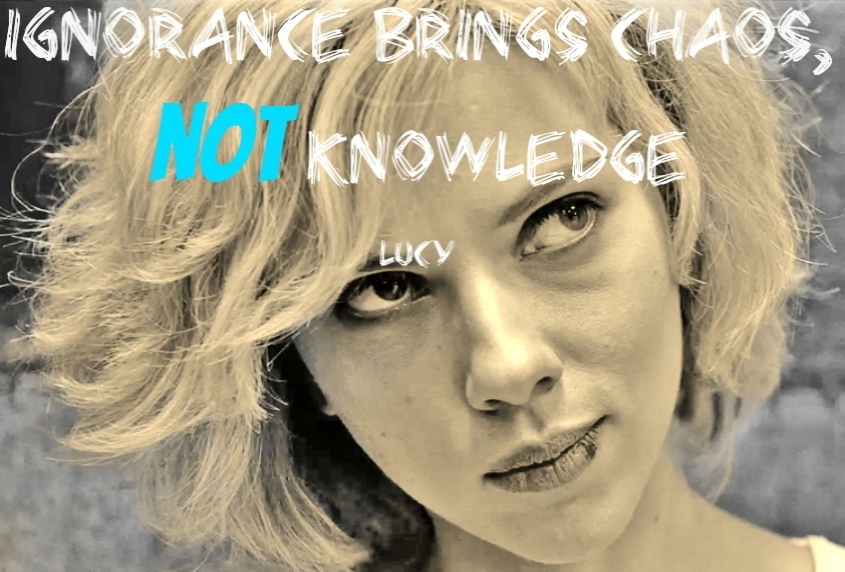
Let’s then reflect on [time,] in an attempt to glean what clues we might from a handful of films, life experiences, idioms, and inceptions, drawing out a jot of harmony from a lot of chaos.
A Broad Map of Time
Let’s start by summarizing the major impending points regarding time and drawing a broad map to get a sense of what’s coming up next, before we begin our cinematic journey.
What does [time] mean to you? Start with the most fundamental common sense: Time is what our clocks measure. Isn’t that so?
Is time, then, just a series of digits on a clock?
Let’s go over some of the causes of timepieces afresh: In a world full of alterations and quagmires, clocks might have been developed as a result of humans’ desire to synchronize their lives with the flows of nature and create common ground among members of a single community. What is the technique behind the usage of clocks to keep track of time? It appears to be a process of counting the amount of change based on a preset spectrum of change determined by convention and used as a unit of reference.
Though time seems to be dependent on man’s rational activity of counting and discerning the best way to do so based on practical considerations, man’s inspiration has always been backed up by facts. So, what are some of the facts at hand?
One cannot react in chronological order in a situation unless he has firsthand knowledge of how the situation’s components may evolve. Any event that one experiences reflects consecutive steps of change from one previous state to the next, while it’s marked by a temporal length from beginning to end. Etc…
Humans appear to experience time and change in lockstep, as evidenced by this and other observations. But, what is the link between time and change, one might wonder?
Let’s look at some ordinary idioms: Time allows us to detect greater and lesser change, and number allows us to discern the greater and lesser. As a result, time can be thought of as a kind of number. Given that time and change are inextricably linked, we might say that time is a measure of how much things have changed.
In a word, the human reason and the architecture of change co-create time!
Let us now move on to further specifics in light of the several films that have been selected.
A Reflection on Man’s Ordinary Daily Life’s Experience of Time
The simplest way to think about time may turn out to be: Time is what clocks measure. It is analogous to when one says that temperature is what thermometers measure. Though this remark about time seems trivial, it subsumes a profound fact about our universe: It can have so many clocks. What’s fascinating about clocks is that they follow a predictable pattern. To put it another way, our universe contains a plethora of regular processes that can be employed as clocks.

Most likely, there is now a clock under your nose; perhaps on the screen? What are you waiting for if you haven’t already? Bring some timepiece and place it in front of you. Ensconce yourself and feast your eyes on it:
- 8:02 PM
- 8:03 PM
- 8:04 PM
- 8:05 PM
(…)
You may not be capable to stay more than 1 or 2 minutes. Do you have any idea why? The simple reason being is that you’ll most likely be bored: no eventful memories, no thrilling predictions, no new information, no critical events, no substantial changes in front of you except some mounting numbers. What if you were told that all you had to do for the next 24 hours was stare at a clock? It would take an eternity, and you’d probably lose your mind. However, if you engage with it, the time flies swiftly and the numbers grow chop-chop. In The Clock, Christian Marclay made an entrancing clock to stare at.
The Clock
A 2010 art installation by Christian Marclay. It is a looped 24-hour collage of clips from television and cinema history. The artwork acts as a clock, and the presentation of the clips is synchronized with real-time.
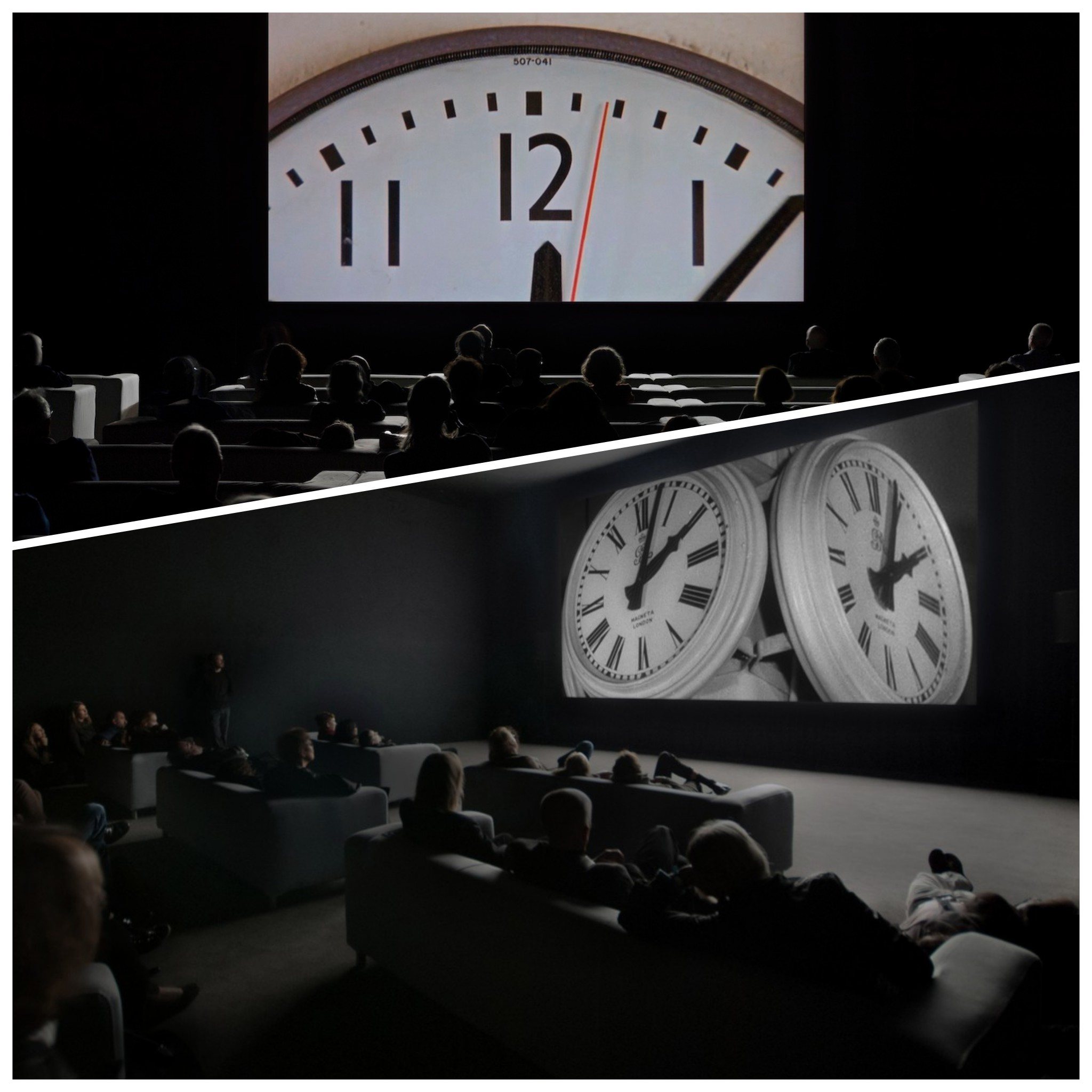
With a limited amount of time and a ticking clock in front of him, what did Marclay say about The Clock? In June 2017, he was interviewed by [Out of Sync] for three minutes, and the following are just a few excerpts from that interview:
[00:00] (…) I don’t know what time is, I know that I have never enough time. We’re obsessed with time and it’s a stressful thing. We’re much happier when we don’t have to think about time. Here in this film, you have to think about time constantly, so it’s a kind of meditation on time. (…) if you engage with it, the time goes by quickly, yet if you’re bored, time seems endless. [02:21]
Christian Marclay
To be continued…
A Musing on What Appears to Be One’s Simplest Reflection
Does conceiving that [time is what the clocks measure] impose an implicit assertion that [there is nothing more to time than the numbers on the clocks?] Does the nature of time have anything to do with the numbers displayed on the clocks? What is the relationship between the numbers on the clocks and the way the world works? What is their relationship with man’s mind?
…The Clock
[02:21] (…) The process of editing for me was the most fun. It’s just like finding a logic between all these fragments, finding connecting bridges, finding cutaways: One action happens in one film and the reaction happens in another. Someone opens a door enters a different world, a different film. These editing tricks are used to create this sense of continuity, this flow, and this make-belief in a way. [03:00]
Christian Marclay
Let’s get acquainted with The Clock by taking a tour d’horizon of some of its segments, as recounted in general by [Out of Sync:]
- At around 7:00 a.m.: the characters are shown waking up.
- From 9:00 a.m. to Noon: they eat breakfast and have wake-up sex. As Noon approaches, a sequence of action scenes builds up to bells ringing in High Noon.
- Between 4:00 p.m. and 5:00 p.m.: transportation becomes important as characters travel on planes, trains, and automobiles.
- At 6:00 p.m.: the characters eat dinner and have shootouts.
- In the Evening: they attend parties.
- At 8:00 p.m.: theaters and orchestras begin their shows. As midnight approaches, the characters become more frantic, throwing tantrums and requesting stats of execution. Screeching violins from multiple clips build up to the moment.
- At Midnight: Orson Welles is impaled on a clock tower in The Stranger, and Big Ben explodes in V for Vendetta.
- After Midnight: the characters go to bars and drink. In the early hours, they are generally alone or sleeping.
- Between 3:00 a.m. and 5:00 a.m: several dream sequences occur.
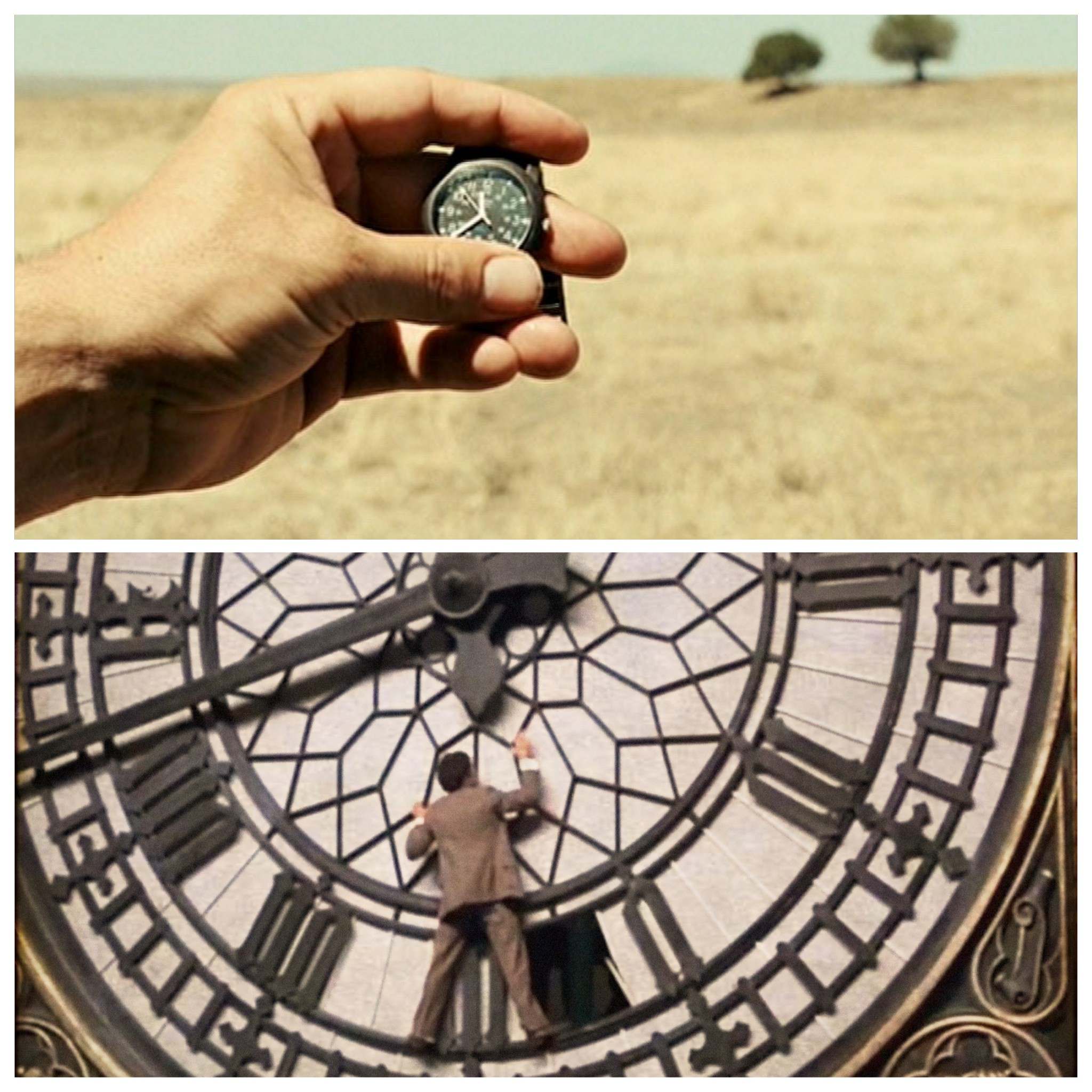
It may be impossible to tolerate 24 hours of watching a clock. However, audiences would find themselves spending far more time in front of The Clock than they imagined. Because The Clock is more than just a clock with some numbers on it they would frequently lose track of time. The Clock lays out a group of possibly compatible scenes with a sense of order.
Now consider this: Is using a clock to count units of time simply a means of arranging events in a before-and-after sequence? Is this to imply that time is only a creation of the mind? Isn’t there anything about how the universe works at the back? So, is there a natural order to events that can be accounted for in terms of time? Well, does time, purported to be quantifiable according to clocks, have any aspects associable with man’s intelligence on the one hand, and real-world functioning, on the other?
Is Time Just a Man-Made Conceptual Tool?
What Makes Humans Stand Out?
Obviously we have similarities. We have similarities with everything else in nature; it would be astonishing if we didn’t. But we’ve got to look at the differences.
Ian Tattersall: a paleoanthropologist.
For many years, scientists thought that modern humans’ capacity to use tools set them apart from other species. However, it was later learned that humans weren’t the only ones who utilized tools: chimps and a variety of other animals have also employed tools to achieve their objectives.
Now that man’s tool-using behavior no longer needs to distinguish him from some other living organisms, might it be crucial to examine the roles and functions that have led him to the identification or innovation of useful tools, as well as their inheritance or transmission?
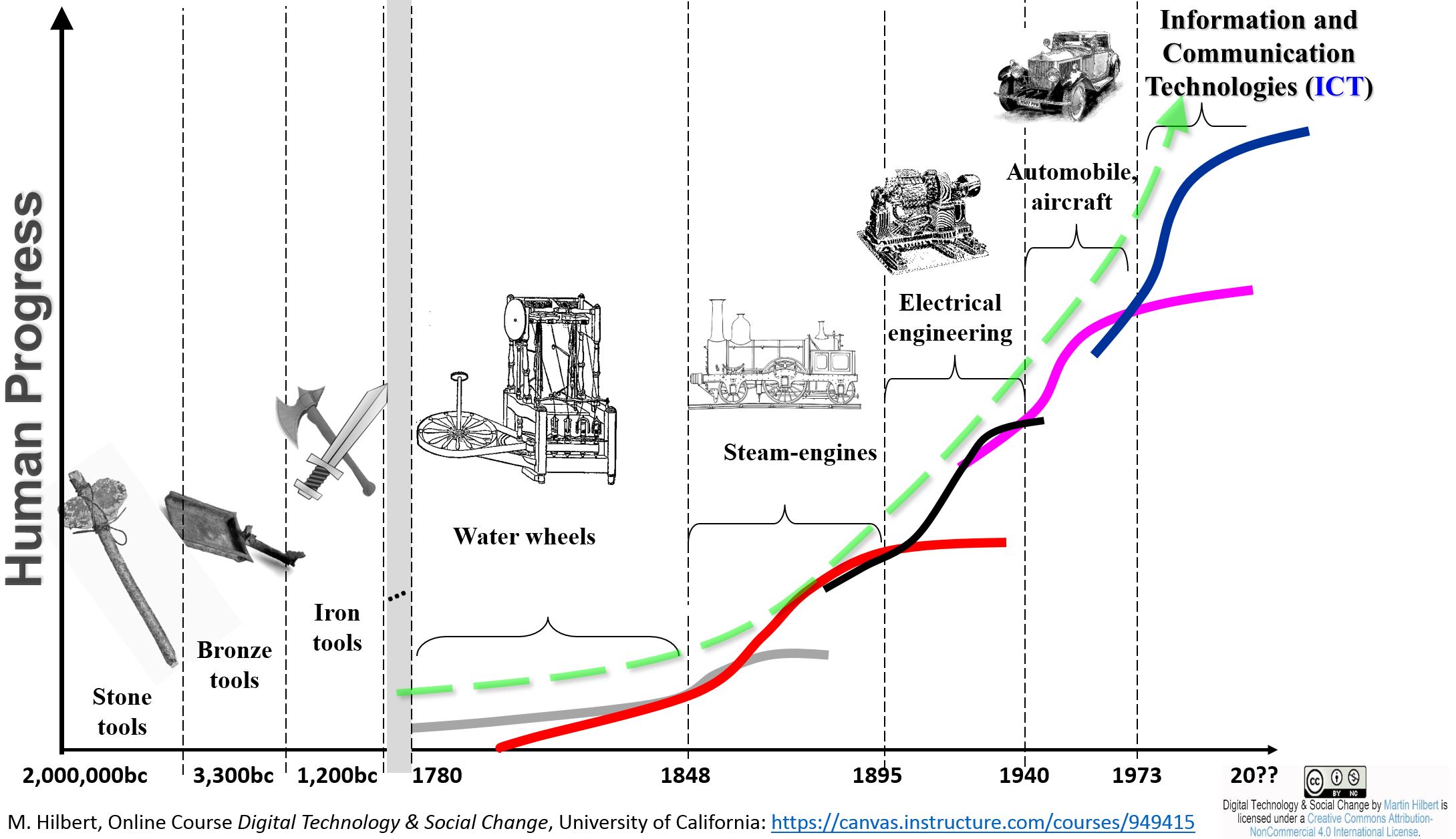
A loud state of activity made its way and change became the status quo once humans began behaving in an unusual more sophisticated manner.
Man’s stone tools grew more complicated, and this was a milestone on the road to developing superior technical artifacts. Artifacts such as geometrical drawings on plaques and cave paintings were assigned symbolic values. As a way to reflect on the world around them, humans began using symbols that resembled language. These mental symbols eventually evolved into a full-fledged language. Then came speech, which appears to have been fueled in part by another distinctively human quality: outstanding social ability. As it happens, chimps appear to cooperate only when there is something in it for them. Without a doubt, humans do this as well, but they are also concerned with what their partner receives. Furthermore, while chimps mostly share with close relatives, reciprocating partners, or potential mates, humans are less picky about who they share with. Man’s cooperative skills could be linked to his ability to reflect on what he sees and pays attention to. He has not only developed the ability to think about his sensory experiences of the world, but he has also got the potential to think about his thoughts, to grasp both his knowledge and his ignorance, which provides the fuel for questioning, for tuning to his needs, and for demanding certain things. One has a sense of what other people know based on his knowledge of the world, but one also has a sense of what they don’t know, which fosters him to comprehend others, listen to their needs, and meet their requests.
Chimpanzees know what others know and what others can see, but not what others believe.
Michael Tomasello: a psychologist.
Several studies have been conducted to see when kiddies commence discerning the presence of false ideas. One of these attempts is recognized as the Sally-Anne task. In the experiment, young people have been with two dolls: Sally, who had a basket, and Anne, who had a box. After placing a marble in her basket, Sally exits the room. While Sally is out, Anne gets the marble from the basket and places it in her box. Sally returns to the room at last. The researcher asks the toddler three questions:
- Where will Sally look for her marble?
- Where is the marble now?
- Where was the marble before?
The first question is crucial; if children respond by pointing at the basket, they have demonstrated a comprehension that Sally’s knowledge of the world does not represent the current situation. If they instead point to the box, they fail the test, presumably because they haven’t considered that they have access to information that Sally doesn’t. The other two questions are essentially control conditions; if either of them is answered incorrectly, it could indicate that the child didn’t grasp what was going on. Most 4-year-olds did the task well. They know the marble isn’t there, but they also know Sally is missing crucial information.
We are certainly unique in the level of abstractness with which we can reason about others’ mental states.
Katja Karg: an evolutionary anthropologist.
The Humans
A 2021 film by Stephen Karam, based on his one-act play of the same name. It stars Richard Jenkins, Jayne Houdyshell, Amy Schumer, Beanie Feldstein, Steven Yeun, and June Squibb.
Three generations of the Blake family gather for Thanksgiving: Deirdre (Houdyshell) and Erik (Jenkins), together with Erik’s Alzheimer’s-affected mother (Squibb), had journeyed hours to meet their younger daughter, Brigid (Feldstein), and her boyfriend, Richard (Yeun), at their new apartment, as does their older daughter, Aimee (Schumer).
Erik has been having reoccurring nightmares, Deirdre feels underappreciated, Brigid is determined to prove to her parents that she is self-sufficient, Aimee is still recovering from a recent breakup and career disappointments, and everyone appears to be suffocated by their thoughts. The film follows the emotional ups and downs of commoners bound by tradition, rivalry, and unwavering duties. From politics to religion to the morals of living one’s life, the Blake family can’t agree on anything. Long-simmering resentments are rekindled, and painful announcements are made. They’re feeling uneasy about where they are, who they’re with, and the emotional baggage they need to untangle, yet can’t seem to connect. Howbeit, sharing their pleasures and pains adds to their worthiness, as each acknowledges that their contrasts help them to grow stronger. As much as The Humans is about people hurting each other, it can also be interpreted as a story about people yearning to connect, communicate, and comprehend one another. The film appears to be concerned not just with people’s fears and anxieties, but also with what it means to go through life not alone and to be accepted despite being an imperfect person. The Humans is about the significance of rapport in volatile times.

What has already been mentioned describes the interactions amongst the characters in a broad sense: Individuals who perceive, analyze, imagine, and respond to the environment, how things stand, and the turn of events, including their experiences, knowledge, ignorance, and mind’s eyes, as well as the experiences, knowledge, ignorance, and ideas of others. What about the audience’s involvement with the film’s characters? As observers, our encounters with virtual (or real) scenarios of individuals thinking, envisioning, dialoguing, and interacting appear to be one-of-a-kind. Consider how many conversations you’d like to be able to hurl yourself into in whatever movie you’re watching and say, [No, no… she doesn’t mean this, she means that!] [Put an end to it! He has absolutely no idea!] [Please, please, please, please! Observe! He’s got your back!] and so forth.
Jayne Houdyshell remarked in an interview with [Variety Studio] at [TIFF:]
I think one of the things that people will take away from the film is their own family. I think there’s a decided kind of and unique relatedness that people feel in watching this film, and the lives of these people play out that will be deeply resonant and recognizable for the people viewing it, and hopefully, they’ll leave the theater wanting to call their mothers and fathers and say, [Hi!]
Jayne Houdyshell
Humans share stories, envision things about themselves and others, and spend a lot of time turning over what may show up subsequent and analyzing what they already comprehend. They responsibly steer their behavior by drawing on the experiences, reflections, and imaginations of others. They join their minds, amassing information over several generations, and so on.
Henceforward, our question becomes: What qualities allow an organism to advance a range of advanced tools devicefully, methodically, interactively, collaboratively, progressively, recurrently, and so on?
Leaving aside the several sorts of Lifeforms’ traits that appear to be useless in terms of natural selection but are explained by other evolutionary mechanisms (such as vestigiality, genetic drift, genetic hitchhiking, etc…), many traits have been credited with aiding survival in some ways. Humans, meanwhile, appear to have augmented a sui generis cognitive apparatus that makes a mark, despite their forebears’ genetic heritage living on through them.
But if our shared genetic heritage can explain the evolutionary origin of the human mind, then why isn’t a chimpanzee writing this essay, or singing backup for the Rolling Stones or making a soufflé? Indeed, mounting evidence indicates that, in contrast to Darwin’s theory of a continuity of mind between humans and other species, a profound gap separates our intellect from the animal kind.
Marc D. Hauser: an evolutionary biologist.
According to Hauser, four intellectual qualities are unique to humans:
- The first is generative computation, or the ability to generate a virtually limitless variety of expressions, whether they are word arrangements, note sequences, action combinations, or strings of mathematical symbols.
- The human intellect’s second distinguishing feature is its proclivity for the promiscuous combination of ideas.
- The third characteristic is the use of mental symbols. We can convert any sensory experience, real or imagined, into a symbol that we can keep to ourselves or share with others through language, art, computer code, etc…
- Fourth, only humans think in abstract terms.
But still, how these factors are combined in the culture-making maneuver differs greatly from one tribe to the next. Distinct languages, moral standards, and artifacts exist in different human civilizations. No other species offers such a broad range of lifestyle possibilities.
A Brief Word on Abstractions
In terms of cognitive activity, let’s make a distinction between two operational patterns that can lead to two utterly different families of so-called abstractions:
- The first family of abstractions that one may consider includes humanness, contradictoriness, beforeness, and so on. These are the outputs of selective attention whereby incidental aspects of several items are disregarded while others are recognized. Let’s take the example of [humanness:] When a person grasps the concept of a human being, he or she has learned to disregard the incidental aspects of each person’s unique distinctions in favor of the relevant trait that they all have, namely, humanness. Here, the process is more of an objective process by which we get to be aware of the attributes and types of individual items than a purely psychological one by which we develop to have ideas. That is while being a mental activity, abstraction is grounded upon genuine contrasts between different components of the world. The following is a more [generic] pragmatic form of the process: Within the framework of a presupposed interest, filtering out – disregarding – the items’ aspects that we don’t desire to focus on the ones that we do. It however includes cases involving a subjective touch, such as dealing with a pencil as if it were a point, or as if it were a line…
- Mickey Mouse, a cartoon character created by Walt Disney, and a centaur, a creature from Greek mythology, are two examples of the second family. They are the result of a creative process, notably imagining, that involves a synthesis phase in addition to the abstraction phase. Although the act of imagining abstracts some aspects of previous perceptions and experiences, it also reassembles them in new ways. A more [specific] pragmatic process may be: Mapping some real aspects of things in the world onto a new useful representation. Niels Bohr commented on defining atomic models in classical physics terms, as quoted by Werner Heisenberg in Physics and Beyond: Encounters and Conversations, “We must be clear that when it comes to atoms, language can be used only as in poetry. The poet, too, is not nearly so concerned with describing facts as with creating images and establishing mental connections.”
Back to the Progenitors of Modern Man
Modern man’s forefathers and mothers were continually reflecting on their experiences: They had been examining their perceptions, recognizing patterns, abstracting ideas, synthesizing information, posing questions, drawing plans, deriving tools, engineering their environment, learning new things, celebrating their fulfillments, striving for continuity, grieving what they had been missing, attempting time and again after every failure, transmitting their expertise and knowledge, etc… All of these enterprises involve all four of Hauser’s qualities. In this vein, devising clocks arose from their quest to synchronize the rhythm of their lives with the rhythms of nature, to create a common ground among members of a single community, to better reflect on others’ thoughts, to communicate and cooperate efficiently, and so on, in a world full of changes and challenges.
Facilely Speaking
They may have first relied on the patterns of the seasons to put things in order, marking time as the leaves alternate color, the days get shorter, the rivers flood, some fruits ripen, etc…
The paintings found in Lascaux Caves in France may be evidence of man’s first attempt to measure observable changes and use them in the daily struggle to survive. The paintings, according to Michael Rappenglueck, may represent a useful giant calendar for the people who painted them. Some parts are maps of the stars: They painted the sky, but just the bits that appeared to be beneficial to them. Other parts show a group of dots and squares painted among images of animals. Each dot represents a 7-day phase of the moon, Rappenglueck thinks. Accordingly, these dots chart the course of time. He explains to BBC’s 2013 documentary Precision: The Measure of All Things:
A stag represents autumn equinox, and it’s starting a line cycle to the horse. The horse represents springtime and you see the horse is pregnant, highly pregnant. So three-quarters of a year are represented on the wall.
Michael Rappenglueck: a researcher in the field of archaeoastronomy, ethnoastronomy, and cultural astronomy.
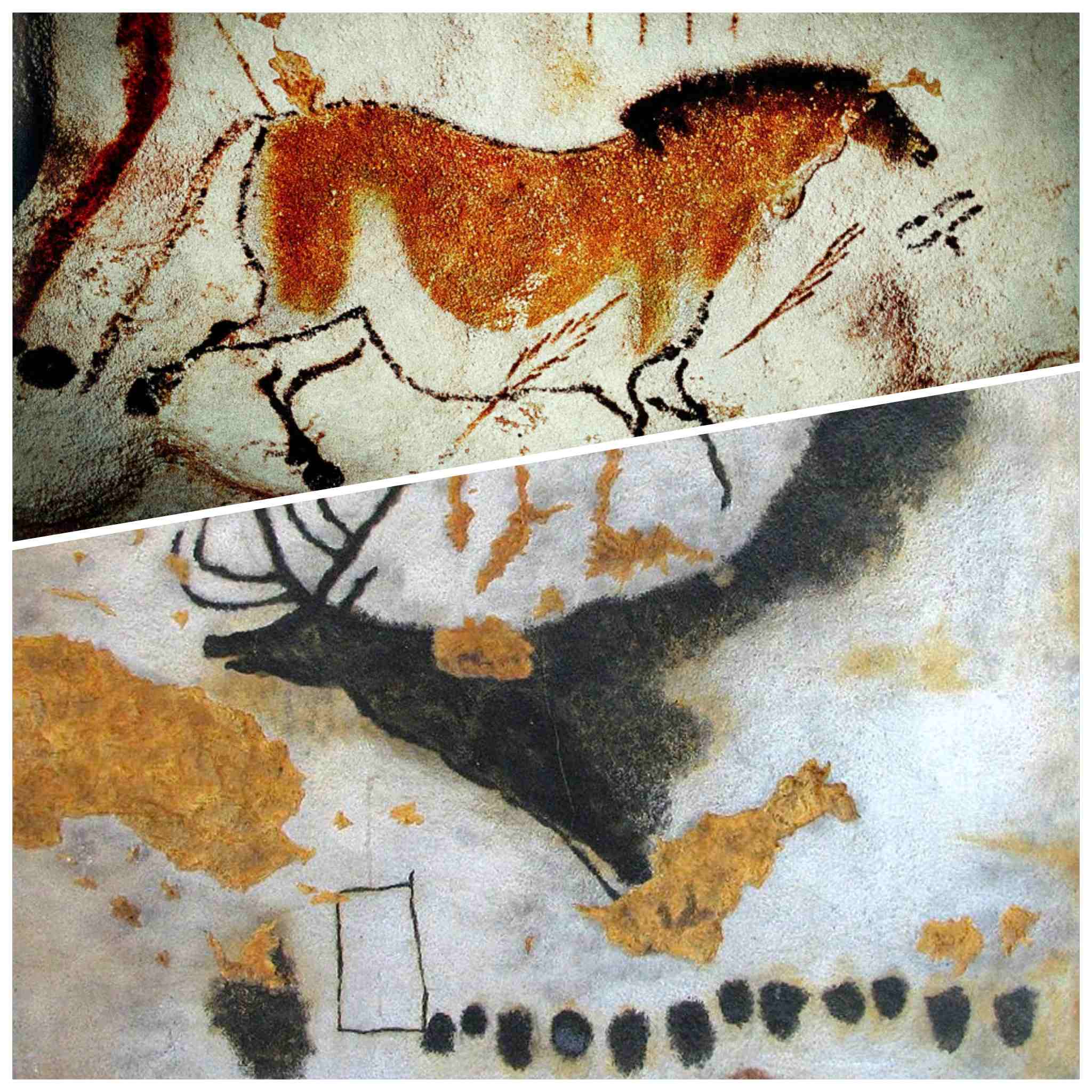
In terms of practicality, it appears that they were concerned with the rhythms of nature. They synchronized the biological rhythms of animals with astronomical rhythms so that they shall be able to predict what would happen at every phase of the abstracted patterns, and then organize their lives accordingly: They can put together to hunt when animals migrate close to them, determine the best time to plant crops, etc…
As their lives had tended to incorporate increasingly complex activities, they had to explore supplementary means that rely on something other than [the long-term rhythms of nature e.g. the cycles of the moon, stars, seasons, and so on.] A method of dividing the day was required for efficiently organizing their daily tasks. They were inspired by how the length of a shadow changes throughout the day. Every change represents a thread of continuity pointing to a connatural end. If the line-like continuity were to be divided, point-like limits would be created. When two limits are mapped up, grasping them together marks off a definite extent that can be used as a unit of measurement. From now on, counting will be a part of one’s life. Counting involves taking a unit of measurement as if it were indivisible and using it to generate a number. In other words, by doing so, one devises a technique to count a number by some defined change, which other changes would be measured by. So they created a tool in which the change of the shadow throughout the day was separated into 12 units. Nonetheless, such a tool is not without limitations. It cannot function when it is cloudy or at night. As a result, they needed to come up with a far more adaptable strategy. They relied on simple, artificially induced movements. Take a bucket, draw determined lines down its side, drill a hole in the bottom, and fill it with water: as the water drops out, it will inform you how much time has passed. One may now measure 12 hours without relying on the changing shadow cast by the sun, but one must still rely on something moving. In like manner, for another precision, one can get the ball rolling by dividing the generated units of time into further little intervals, and these little intervals into even more little intervals, and so on. Allow an hour to be 60 minutes, a minute to be 60 seconds, and so on until you reach the tiniest unit you may generate, if it can’t be detected with one’s senses, then with some artificial apparatuses or even pure mathematical reasoning.

A fair question to ponder is: Why the numbers 12 and 60 were chosen?
Is there anything fundamental about these numbers that relates to the nature of time? Is it merely a case of conventions? And, if so, why were they chosen over other numbers? Is it because of their utility? If that’s the case, why did they prove to be more useful than other numbers?
These numbers turn out to be crucial in the commercial world. Their mathematical features, which make them highly divisible, account for their relevance. Let’s look at the number 60 as an example. 60 eggs can be arranged as follows:
- 1 group of 60 eggs
- 2 groups of 30 eggs
- 3 groups of 20 eggs
- 4 groups of 15 eggs
- 5 groups of 12 eggs
- 6 groups of 10 eggs
If we take 100 eggs, we can properly divide them into 2, 4, or 5 groups. But how do you divide them into 3 or 6 groups? It necessitates the breaking of one or more eggs into many pieces.
Why 12 and 60? Because their mathematical properties make them instrumental and efficacious; id est, using them is operationally advantageous. Though time seems to depend on the activity of man’s reason that can divide, count, and choose the ideal way to divide and count based on practical preferences, (a) for something to be effective, it must possess specific attributes; otherwise, anything, whatever it is, would turn out to be convenient, which is not the case, and (b) to count something, it must be countable in the first place. Man’s creativity has always been backed up with facts. Anything he creates must have predictable behavior to be productive, and predictability is strongly tied to persistence, which requires it to be intertwined with some essential aspects of the real world. So, let’s continue our journey and see what these aspects do seem to be.
Time and Man’s Experience of the World Functioning
Let us rummage through our recollections, recalling a handful of events that we witnessed and attempting to decipher them.
Any event one comes across tends to draw sequential steps of change from one prior state to another posterior state, while from inception to end, it is marked by a time span:
- The elderly lady first takes the pot with great care, then plants a bean with zeal. Soon later, the bean sprouts without warning, and then matures into a plant.
- First, they fell in love at first sight, thenceforth they made warm memories of times together, afterward, they suddenly broke up, after some time, they met again somewhere at night, so they pass many minutes exchanging perfervid glances, subsequently, they bring back some memories, consequently, they had some disturbing feelings, after the event, they thought about their situation.
“We perceive change and time together,” Aristotle pointed out in his Physics, “even if it is dark and we are not acted upon through the body, but there is some change in the soul, it immediately seems to us that some time has passed together with the change. Moreover, whenever some time seems to have passed, some change seems to have occurred together with it.”
Le Haricot
A 1962 short film by Edmond Séchan, starring Marie Marc.
In Paris, an elderly woman lives in a cramped walkup garret. She devotes a great deal of effort to looking after her bean plant. She is determined to succeed and will never give up. For the elderly lady, the bean plant served a purpose. Here’s a synopsis of her story:
On her walk home one day, she discovers a pot with a dead plant in the dumpster. She tosses the plant and keeps the pot, intending to plant a bean in there later. The bean sprouts and develops into a full-fledged plant. When a sheet from upstairs blocks the light from reaching her bean plant, the old lady moves it outside. When a pigeon almost destroys her plant, the elderly lady places it on a chair in the building’s corridor. Eventually, because the conditions were no longer suitable for it to thrive, she takes it outdoors and puts it in a garden. When some gardeners destroy it, the old woman offers the possibility all over again. She rescues some beans to recommence afresh.

Consider how the old woman’s understanding of the world may have influenced her behavior. She performs her actions in chronological order. Following her attention to succession in change, she gets the picture of succession in time, or, in other words, the passage of time. Following her realization of some patterns in the states of things, she gets acquainted with succession in change. Now, appreciating the underlying properties of whichever changing entity is required to mentally map out two states of it, one preceding and one following. To sum up, she won’t be able to react according to a chronological order unless she’s seen how beans may change firsthand, put differently, unless she has a sufficient understanding of the key aspects of beans.
“But time,” Aristotle tells us in his Physics, “we become acquainted with when we mark off change, marking it off by the before and after, and we say that time has passed when we get a perception of the before and after in change. We mark off change by taking them to be different things, and some other thing between them; for whenever we conceive of the limits as other than the middle, and the soul says that the nows are two, one preceding and one following, then it is and this it is that we say time is. So whenever we perceive the now as one, and not either as before and after in the change, or as the same but pertaining to something which is before and after, no time seems to have passed, because no change seems to have occurred either. But whenever we do perceive the before and after, then we speak of time.”
For a moment, let’s squint at dry beans and see how they work. What exactly are these things? Beans that aren’t cooked? Is this, however, the end of the story? Isn’t it possible that they’re all bean plants? [No, no, no!] one may exclaim. It’s true that they can’t be both dry beans and outgrowth bean plants at one and the same time. Nonetheless, (1) they’re currently bean seeds and so [potential] bean plants, and they will become [actual] bean plants later when all of the prerequisites for maturation are met: They’ll grow into bean plants as time passes by. That’s not the same as, say, dealing with pebbles. Planting pebbles in a pot and watering them regularly will not result in bean plants. Alternatively, (2) they’re presently bean seeds with the potential to become bean plants, and they’ll continue to be later dry beans if the proper measures aren’t taken: They’re still dry beans as time progresses.
When considering a relationship between time and change, it would be natural to wonder what that relationship might be like.
Casablanca
A 1942 film directed by Michael Curtiz, and starring Humphrey Bogart, Ingrid Bergman, and Paul Henreid.
Casablanca tells the story of a man who must choose between his passion for a woman and aiding her and her husband in fleeing the Vichy-controlled Casablanca.
A novelist, lecturer, and narrative consultant noted for his Story Seminar, Robert McKee, once said:
This film is about the difference between love and romance. It’s about the possibility that we can be ourselves and change at the same time. It’s a meditation on time itself and what time means. Aristotle said time is a measure of change, and this movie is about changing in time, through time, while remaining the same person. That’s a philosophical paradox and a moral dilemma. But Casablanca says it’s possible. You can have both. That’s what it means. And that’s my wish for you: that you would have both.
Robert McKie
It’s worth noting that Aristotle’s Physics brings in the following statement:
It is manifest then that time is a number of change in respect of the before and after, and is continuous, for it is a number of what is continuous.
Aristotle
Aristotle’s analysis seems to stem from what we identify it natural to say: “We discern the greater and the less by number, and greater and less change by time; hence time is a kind of number.” But there’s more to such ordinary idioms than just the fact that they’ve been repeated. They are implemented in people’s daily lives, it seems, because they reflect some facts about the world we live in. When one thing, [change,] is articulated and perceived, an abstract entity, [a number,] emerges. Such an abstract being belongs to the first family of abstractions discussed earlier rather than the second, hence the operation that leads to becoming acquainted with it is objective rather than subjective, even though the way for counting it and measuring change (or rest) by its virtue turns out to be customizable. Let’s recall the technique utilized to devise clocks. What are the clocks for? They’re supposed to be used to keep track of time, aren’t they? What is the cornerstone for their timekeeping? Every clock has some form of change as its main feature to measure time. But, specifically, how does one make use of change to measure time? One would be able to count and learn about time by locating some change and using it as a unit of measurement (a unit is defined by two limits: a before and after in change.) But why does one even need to keep track of time? Simply put, humans need to improve their activity management. And in order to accomplish so, they must keep track of change (and rest) in the environment around them as well as in themselves; but time is the determining factor. It’s manifest then that change measures time, and time measures change. So, what kind of [being] possesses such a quality? It has to be some sort of number, right? Consider a multiplicity of things that are right in front of you, such as words. It’s by [number] that you became acquainted with the [multiplicity] of words and, conversely, it’s by [one word,] the unit of measurement that’ll be used to count, that you’ll become acquainted with the [number] of words itself. The same may be said for time and change.
Now how could Casablanca possibly be a meditation on what time means?
Bogart and Bergman’s characters had a favorite song called [As Time Goes By.] The opening lines of the song are as follows:
You must remember this
A kiss is still a kiss
A sigh is just a sigh
The fundamental things apply
As time goes by
(…)
[As Time Goes By] evokes fond memories for them, but it puts a flea in their ears: You’re no longer together whilst your love endures, and it leaves them wondering what’s next. Despite the fact that many things have changed, their love remains unwavering. The song’s concern with things (a kiss, a sigh…) that were true before, are true now, and will continue true after is reflected in the use of simple present verbs.
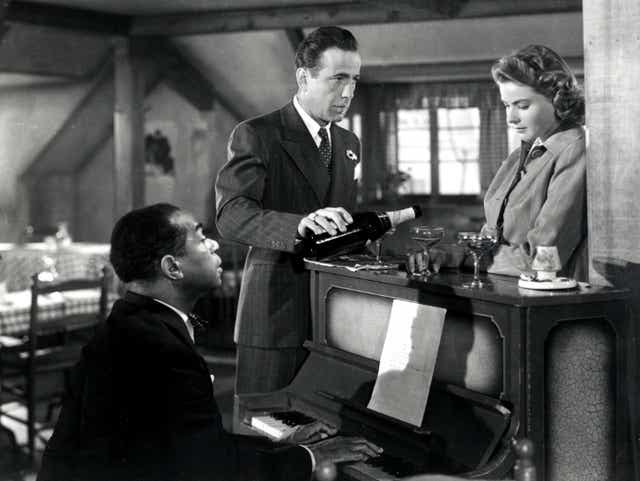
“The fundamental things apply as time goes by:” a simple but deep message delivered by both the film and the song.
What does it mean to say: [as time goes by?] Simply put: [over and over and over and over and over and over and over and over and over…] which illustrates a counting act. Hence, “The fundamental things apply as time goes by” translates to [The fundamentals remain the same as the number that measures change (and eventually rest) increases.]
Beyond Ordinary Experience?
Given man’s quotidian life experiences and ordinary idioms, such as those explored throughout the aforementioned films, one may end up suggesting, as Aristotle did, that time can be described as [a number of change] that’s counted according to a unit of measurement for change defined by two limits, one preceding and the other following, even though [how] to mark out the limits appears to be dependent on man’s responses to what he deems appropriate for his practical goals. In a nutshell, time is co-constructed by the intellect and the structure of change. It’s no secret that this description implies that time isn’t a self-contained, flowing framework that organizes events and creates a sense of continuity between them; but rather, time is an aspect of reality that emerges out of a web of relationships between moving and stationary objects, and would assume one or another numbering structure fessing up to man’s needs.
Beyond the Perceptual Content of Man’s Time-Related Experiences?
Does Time Flow Literally?
One might argue that, if we’re being cautious, [a time that’s flowing] best represents the contents of man’s perceptual experience of time.
Let us consider a few of man’s time-related experiences:
- Seeing the second hand of the clock move around the dial.
- Noticing that the hour hand on the clock has moved.
- Sensing a drop of tears changing position running down one’s cheek little by little.
- Noticing how one’s facial skin has changed and wrinkled over time.
- Hearing a sequence of pitches.
- Identifying the course of events that have led up to a scientific breakthrough.
- Etc…
Is it true that one is witnessing a flowing entity called time? Rather, it seems that the content of man’s perceptual time-related experiences fairly includes succession in change between distinct states of things such as a clock’s second hand moving from the top to the right, then down and then to the left, and back up to the top. One also recognizes greater, less, and equal change while going through a variety of change lengths. So, whence does the sense of time flowing originate? It could be because people sometimes explain themselves in simplistic and metaphorical terms: [as time passes by, as time moves forward, time is flying, fast times, as days went, as years roll, etc…] The metaphor about time being like a river with its own distinct flow may be an example of the trend of verbal expressions people are accustomed to. In other words, their picture of a flowing time seems to be based on some subsequent imagined fabrications set and propagated publically through frequent linguistic use and accompanying familiarity, rather than their ordinary experience of time. Let’s consider the example of the expression [fast times:] The title of the 1981 novel Fast Times at Ridgemont High, as well as the 1982 film of the same name, helped to inspire the expression. It indicates a period of time marked by frenetic activity, particularly when it involves thrilling events. Another example would be if you were in the middle of an exam and were told that 25 minutes had passed. Does such an expression avouch that time is a flowing entity? Instead, [25 minutes had passed] alludes to the fact that your exam engagement time from the commencement of the exam to the moment shortly before we tell you the time, as recorded by our clocks, is equal to 25 units called minutes.
What’s [Being in Time?]
To argue that events are [in time] and [surrounded by time] does not imply that there is a separate object called time that contains events. The fact that events occur in time implies that time plays a role in their being. To be in time can be interpreted in the same way that one says something is in number, meaning that there are a certain number of it. Hence, [events are in time] could be interpreted as [their being’s being measured by time.] Similarly, describing events as being surrounded by time may go similar to describing entities as being surrounded by number. Determining the meaning of these expressions is predicated on what must come first as a result of the examination of what time is. They don’t carry any necessary facts regarding the nature of time on their own. Just as they can be used to express one fact, they can be used also to express another. In this paragraph, all that is meant is to understand that these expressions do not preclude time from being a sort of number rather than a container.
Can of Worms?
Let’s take the simple act of planting a bean seed as an example. It has the potential to grow into a bean plant. The network of relationships built with the environment is critical for a bean seed to become a bean plant. Such movement from one state to the next (a dry bean to a bean plant) necessitates a number of unique interactions under many definite conditions. As a result of untangling the rationales bringing about events’ order and interfaces, picturing time as a self-contained, flowing entity that’s responsible for the string of ordered events may lead to entities losing their essences and, eventually, all the potential networks of relationships they draw with their environment. It won’t be necessary to refer to [what water is,] [what sun rays are,] [what air is,] [what bean plant is,] and [what the corresponding networks of relationships can be] to explain the mappings of events with which all of these whatsits are affiliated, because time will turn out to be the one doing the job.
If one has qualms about positing ordinary world reality as made up of entities to which relationships are subordinate, he can approach the preceding issue from a different mindset. Relationships can be identified as basic aspects of the regular, everyday real-world, physical objects as subordinates, and their so-called essences as merely convenient mental shortcuts. Whatever one may think about everyday reality, it mostly pans out to retain kind of omnifarious homogeneities, if not as entities with essences, then as processes with blueprints (the structural features of how processes proceed.)
Time as a Self-Contained, Free-Flowing Framework
Now then, would the only relevant temporal notions be those that are inextricably linked to the perceptual content of man’s ordinary time-related experiences? What about ideas floated via human imagination? One can always imagine time as a vessel of events, ignoring the substance of his perceptual experience, and unfeterred by the sine qua nons for a diverse real-world. One may think of, for instance, a videotape (or its equivalents: movie projector, DVD, etc…) that can display any bunch of scenes in any order. Any olla podrida turns out to be possible. Planting a stone in the soil, for example, can be arranged right before discovering a bean plant sprouting out of the soil where there is nothing else except the stone. In everyday life, it’s just a sown bean seed that’s followed by a bean plant emerging from the soil, that’s it, nothing more, and it might happen otherwise.
Holy motors
A 2012 film by Leos Carax, starring Denis Lavant and Édith Scob.
The film opens with old motion photography of a naked man moving around. The scene shifts to a packed movie theatre. The horns of passing cars can be heard. Up to the noise of a door opening, the sound of footsteps grabs our attention. [No, no, no!] screams someone. A gunshot is heard shortly after. The voices of a ship, seagulls, and sea waves fill the air after that. Meanwhile, we cut to a man and a dog sleeping in the dark. The man awakens. He switches on the lamp. There’s an empty bed next to him. The man’s actions suggest that he is exploring the space. He discovers a locked door. He unlocks it by using his middle finger as a key. He wanders into a movie theater, trailed by his dog. He takes cautious steps forward until he looms above the area. The theater appears to be packed with lifeless spectators at this juncture. Out of the corner of your eye, a naked toddler strolls down the aisle. We cut to that aisle, and there’s now a huge lumbering dog. We cut to the man peering down the aisle: He shifts his gaze to the screen, and a girl looks out a window. At last, we get to the first scene with the main character.
Oscar is making his way to work. He says his goodbyes to his family with a wave. The gentleman gets into a white limousine right away. The driver informs him that he has nine appointments scheduled. He opens a file, uncovers a mirror, and begins brushing a wig. Throughout the day, he is seen dressing up in various outfits and playing various roles at various locations throughout Paris. The following are some of the roles:
- He takes on the role of an elderly beggar.
- He dons a mo-cap suit and enters an empty soundstage. He performs actions while being led by a man who isn’t seen. After a while, a woman dressed in a mo-cap suit appears on stage. They make gestures that are intended to create a sex scene between two animated beings.
- He portrays a bizarre and vicious man who lives in the sewers.
- In a church, he performs a tune on the accordion.
- He enters a hotel room and climbs into bed. His niece walks in, they have a serious conversation about their lives, and then he passes away. He gets out of bed and excuses himself, stating he has another appointment, while she tears.
- He plays a man with chimps for a wife and children.
- Etc…
Regardless of what transpired before, we return to the limo after each role: Oscar has died numerous times, but he keeps going.
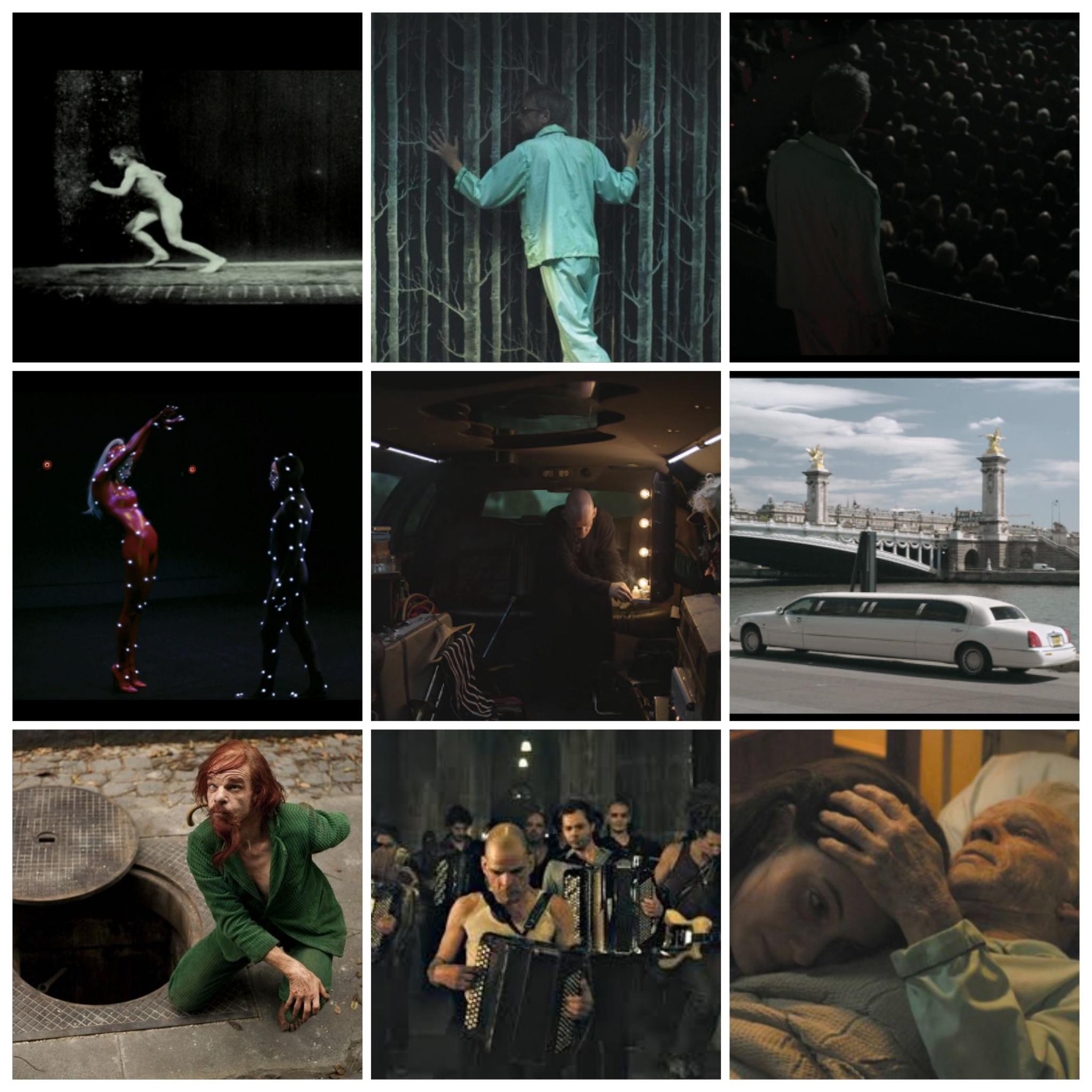
In a fashion that sounds aimless and disconnected, the protagonist takes on new identities inexorably, each time as a different individual. One is often confronted with behaviors that have no ramifications. Nothing seems to add up during the movie. A troubling question looms large in one’s mind: Is there a single, consistent narrative? As one attempts to put all the pieces together, he keeps track of answers to a variety of [why] questions: Why did we cut to old motion photography on several occasions? Why was there a secret door in the room? Why does that man’s finger serve as a key to that door? Why were the spectators lifeless when the man walked into the movie theater? Why, instead of the youngster we saw from the top, do we see a lingering dog when we cut to the aisle? Why is it that we cut to a girl looking out a window? [Through the scenes that feature the main character:] Why do characters seem to vanish at random? Why has Oscar died in one scene only to return totally unhurt in the next, despite the fact that this also occurred during a storyline that seemed to take place outside the context of the 9 appointments? Why disobey logic’s rules? Etc… It’s as though you’re in the midst of a fever dream.
Spencer Hawken, a film producer, director, writer, and film critic, wrote:
Holy Motors is a mind-boggling movie, with oodles of character; it’s funny, emotional, and surprising. It has images that will stay in your head, most notably the accordion interlude, which comes completely out of nowhere, and really takes things up a gear.
Spencer Hawken
Be that as it may, consider the following observations regarding one’s movie experience:
Being a self-contained, free-flowing framework packed with various scenes appears to be unconcerned, on its own, about latching on to any comprehensive cohesive story. One would be poring over the scenes all the time, looking for rationales in the settings, characters, and events, to grasp any set of links between the disparate pieces. One might never be satisfied with a haphazard assortment imposed from outside the scenes.
Every piece is already regarded as a standalone short film. So, although sharing the same dynamic framework, why does each piece appear to be more compact than the entire film? Is it simply a result of humans’ day-to-day routines and the habits that follow? But, even if such is the case, whence do such routines originate? Isn’t there some enduring modus operandi of how the world works?
Let’s see how far one can stretch his imagination: A running movie projector with multiple scenes appears to be insufficient to demonstrate their interlinking and arrangement in a single coherent plot. Is the man who had unlocked the secret door and entered the movie theater, Carax himself, supposed to be offering the logic of the piece of art (or life!) that commences only after he turns at the screen of the movie theater? Is the movie projector nothing more than a tool in his hands? Is he the one who comes up with the narrative structure? Even if the filmmaker is connecting the dots, he or she still banks on the mundane, daily reality; isn’t that so?
At a New York Film Festival press screening for the film, chatting with Amy Taubin and fielding questions from the audience, Carax asseverates:
I see it as a kind of science fiction with more fiction than science. It’s a world not too far from our world but where it could seem, in one day, to tell the experience of being alive and in this world.
Leos Carax
What or who, if not the scenes altogether and their substances, offers the rationales for their compact structure? Is it the videotape that’s the source? Is there someone pointing a finger behind some bald scenes?
When one imagines time as being independent of change, containing events, flowing on its own, arranging and connecting events, his imagination may not stop there, appealing to an [unseen director.] Furthermore, his imagination can take him to a plethora of different orientations: [Why don’t we all be like the man who uses his finger to open the door and then draws meanings? Neither the passage of time nor the rhythms of the world are relevant. Our heads are all that’s there.]
While Oscar is removing his makeup and getting ready for his next appointment, a man shows up in the limo. He’s curious as to what motivates Oscar to keep going, as the latter has recently appeared exhausted. Oscar justifies himself by arguing that the same incentive that drew him to the act in the first place still motivates him to carry on: [The beauty of the act.]
“Beauty! It is said that beauty is in the eye of the beholder!” says the man to Oscar.
“What if there is no beholder?” Oscar wonders.
[What if there is nothing to make sense of?] one’s imagination might go on and on. Shall one’s train of imagination come to a halt here? Almost certainly not. Let us, however, stop immediately.
Time can be imagined as a self-contained background that runs indefinitely, collects, arranges, and harmonizes events into a cohesive whole, and so forth. The question is whether or not the human capacity to imagine something is sufficient to justify its being.
What’s more, in a highly interactive community, referring to clocks as people’s vehicles to some unique and shared self-contained, free-flowing being may seem more practical in terms of expression and communication. But, in a context that goes beyond ordinary practicality, such as how things are in their own right, would the fact that the output of man’s imagination proves to be fruitful be enough to validate it?
On top of that, picturing time as something of itself and from its nature that flows equably and with no regard to anything external may feel beautiful. Presuming that some useful creatures of man’s imagination show to be beautiful: can the aesthetic quality be deemed to be a fair standard?
Lucy
A 2014 film by Luc Besson, starring Scarlett Johansson and Morgan Freeman.
While working as a drug mule, Lucy was tasked with delivering a package containing a valuable chemical. The package was surgically put into her body, but it seeps into her system and grants her superhuman skills, allowing her to fully control her brain.
Here’s a question she was asked: “How did you manage to access all this information?”
She replied as follows: “Electrical impulses. Every cell knows and talks to every other cell. They exchange a thousand bits of information between them per second. Cells grouped together form a giant web of communication which in turn forms matter. Cells get together take on one form, deform, reform. Makes no difference, it’s all the same. Humans consider themselves unique, so they’ve rooted their whole theory of existence on their uniqueness. One is their unit of measure, but it’s not. All social systems we put into place are a mere sketch: one plus one equals two, that’s all we’ve learned, but one plus one has never equal two. There are in fact no numbers and no letters, we’ve codified our existence to bring it down to human size to make it comprehensible. We’ve created a scale so that we can forget its unfathomable scale.”
She is then confronted with the following question: “If humans are not the unit of measure and the world isn’t governed by mathematical laws, what governs all that?”
This is what she said: “Film a car speeding down a road. Speed up the image infinitely and the car disappears. So what proof do we have of its existence? Time gives legitimacy to its existence. Time is the only true unit of measure. It gives proof to the existence of matter. Without time we don’t exist.”
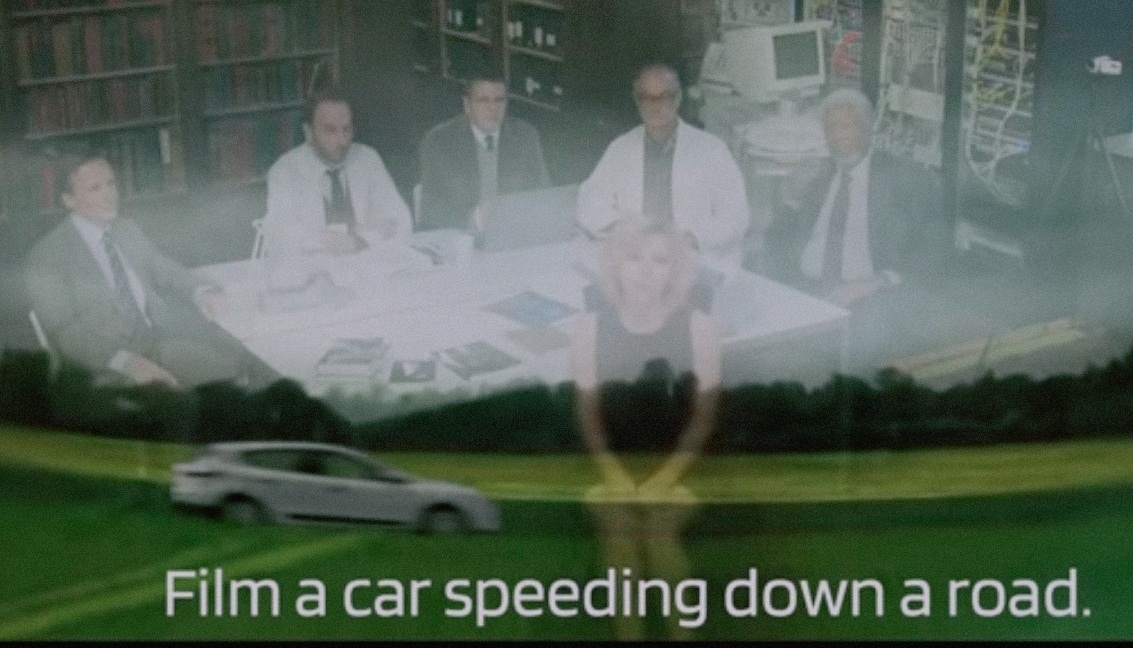
That’s both beautiful and surprising. It’s beautiful, though, because it’s surprising and out of the ordinary. Lucy’s real-life scenario has a more poetic than scientific air to it. Perhaps, in the end, the way Lucy depicts reality will prove to be satisfactory; yet, en attendant, it soon becomes apparent that it comprises assumptions that are not only multiplied beyond necessity but also nullify all that appears to be operating perfectly. But since anything that can be asserted without evidence can equally be refuted without evidence, the simplest description of time is what we have already learned from our everyday experience.
Time: Even as Something More Than a Receptacle for Events?
It has been said:
Time is a great teacher, but unfortunately, it kills all its pupils.
Hector Berlioz: a composer and conductor.
In his physics, Aristotle stated that time has an effect on objects, just as one says [time wears things away,] [everything grows old with time,] and [everyone forgets because of time,] but not [everyone learns because of time,] or [becomes young.] Because time is the number of change, and change removes what is present, time is accountable for ceasing-to-be rather than coming-to-be. As a result, it is clear that things that always exist, when examined as such, are not in time, because they are not measured by time, and then, they are not acted on by time either.
Now that [time acts upon objects] appears to simply indicate that objects in time or measured by time are described as changeable, in other words, that things being this or that way because of time means that they couldn’t be this or that way if their nature doesn’t provide changeability, that’s all.
Albert Einstein died on April 18, 1955, when he was 76 years old. Is it true that time has robbed him of his life, literally? Not in the least. Nevertheless, one may recall more serious motives to speculate that time has causal powers, or, to put it another way, acts as a source of change or stability for the objects:
Adapting from the earlier book Gravitation, I wrote: “Spacetime tells matter how to move; matter tells spacetime how to curve.” In other words, a bit of matter (or mass, or energy) moves in accordance with the dictates of the curved spacetime where it is located. At the same time, that bit of mass or energy is itself contributing to the curvature of spacetime everywhere.
John Wheeler: a theoretical physicist.
What does this signify, though?
The theory of General Relativity states that mass produces gravitational fields. The energy of a gravitational field affects the rate of an action that takes place within it. Even though the theory by itself doesn’t specify the process that leads to this change, the Einstein field equations precisely predict its degree.
Many interpretations of the mathematical model can now be used to concretely comprehend how things may be progressing. Take a look at the three interpretations below:
- The geometric interpretation: It holds that gravity can be reduced to spacetime geometry.
- The field interpretation: It asserts that spacetime geometry can be reduced to gravitational field behavior.
- The egalitarian interpretation: It claims that gravity and spacetime geometry are conceptually tied.
Nothing, however, stops us from putting alternate interpretations. For example, one could argue that time (together with space) is a system of measurement rather than a substance that can curve. Time (like space) is not a substance, a fabric, a form or source of energy, or a field, but rather, a measure of a specific aspect of physical reality, such as the movement of an entity in motion. In General Relativity, spacetime can be defined as the combination of space and time measurement systems. Nothing precludes us from interpreting general relativity in this sense, because general relativity does not require any specific tangible image. Any interpretation stems from philosophical inquiry or, at the very least, imagination, which is founded on earlier common-sense experiences. Aside from being a prediction tool, the theory can only serve as a foundation for a variety of options. Which alternative best describes what is real is a different question, the answer to which is found outside the theory itself.
Because mathematical forms are at the heart of all such theories, physicists commonly utilize poetic language to express them in common parlance. So, what does it imply when someone says, “Spacetime tells matter how to move…”? It could well be pure poetry. Even if it may turn out to be deceptive in terms of actual reality, it is magnificent poetry.
On his public television show, Closer to Truth, Robert Lawrence Kuhn interviews scientists and philosophers. He was once told the following:
I have the distressing experience of physicists telling me that time is not real. (…) It confuses me, because time seems to be real. Things happen. When I clap my hands, it happened. (…) I would prefer to say that general relativity is not the final theory than to say that time does not exist.
Fotini Markopoulou-Kalamara: a theoretical physicist.
Change: An Illusion?
Many people believe change is an illusion. Where does one get such an idea?
When interviewed by Robert Lawrence Kuhn, Huw Price asserts the following:
What physics gives us is the so-called [block universe,] where time is just part of a four-dimensional space-time (…) and space-time itself is not fundamental but emerges out of some deeper structure.
Huw Price: a philosopher.
To Robert Lawrence Kuhn, Max Tegmark states the following:
We can portray our reality as either a three-dimensional place where stuff happens over time or as a four-dimensional place where nothing happens [block universe] – and if it really is the second picture, then change really is an illusion, because there’s nothing that’s changing; it’s all just there – past, present, future.
Max Tegmark: a physicist, cosmologist and machine learning researcher.
Arrival
Denis Villeneuve’s film from 2016. The film stars Amy Adams as Louise Banks.
Amy Adams stars as a linguist who is tasked by the US government with attempting to communicate with alien visitors whose spectacular ships hover over various sites on Earth. As she learns their language, which is a visual script displayed in intricate circular patterns, she realizes that these circular shapes are sentences made up of multiple words that are read all at once, in a form that has neither beginning nor end, rather than sequentially, as in human languages, where humans speak in a linear fashion, one word at a time, from start to end. We realize towards the end of the movie that simply learning this language changes her perception of time. Instead of seeing events unfold in chronological order, she sees her entire life unfold in front of her.
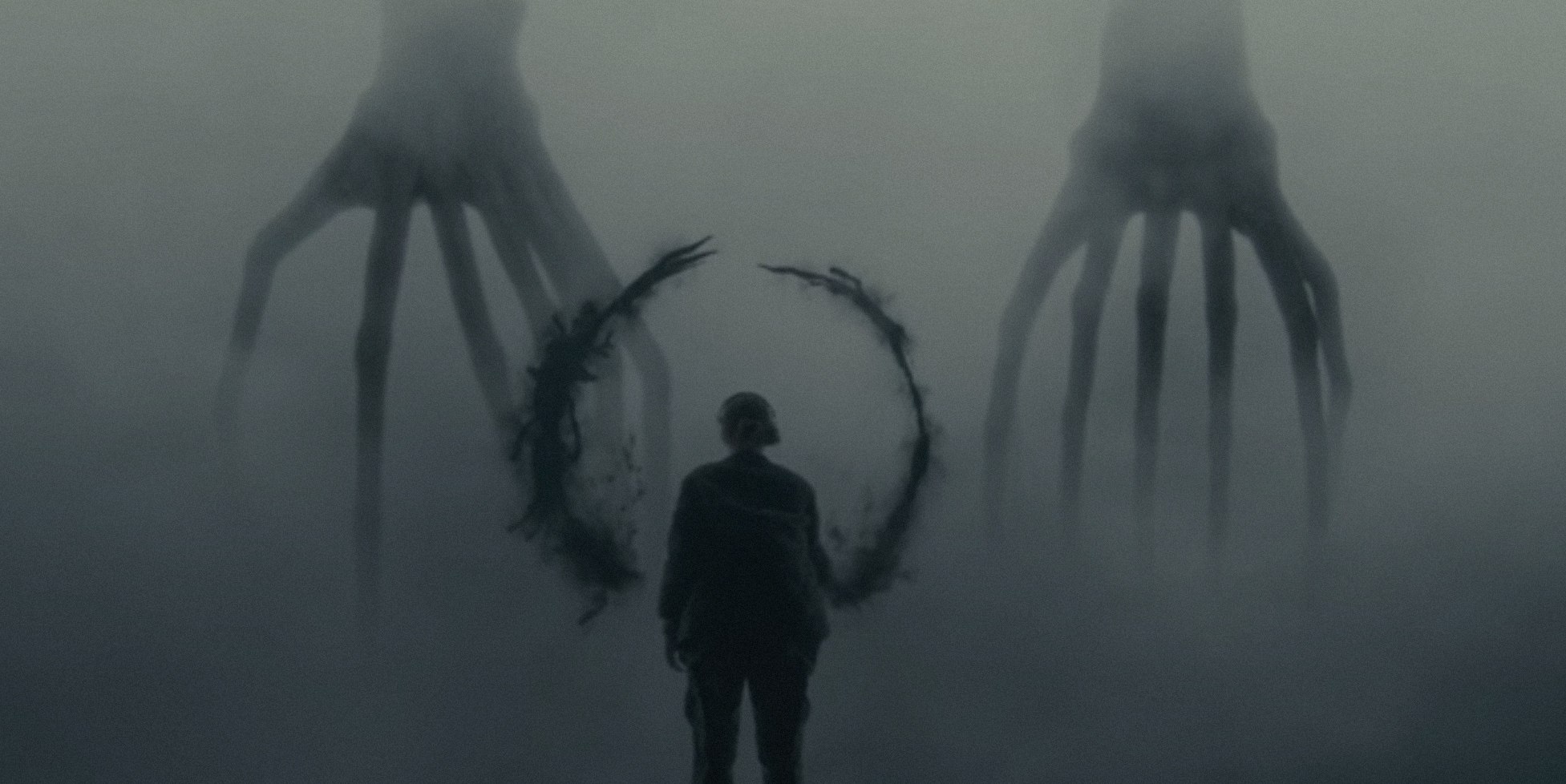
When interviewed by Robert Lawrence Kuhn, Max Tegmark added:
So life is like a movie, and space-time is like the DVD, there’s nothing about the DVD itself that is changing in any way, even though there’s all this drama unfolding in the movie. We have the illusion, at any given moment, that the past already happened and the future doesn’t yet exist, and that things are changing. But all I’m ever aware of is my brain state right now. The only reason I feel like I have a past is that my brain contains memories.
Max Tegmark
With this perspective inspired by such an understanding of the theory of relativity, nothing is moving between different states, instead, everything is seen as a series of snapshots unfolding one after the other. If all of the snapshots were lined up, we’d be able to witness every event that has ever happened or will ever happen.
Consider the implications:
- There are no events, no objects changing and persisting, thus each item must have an infinite number of variants coexisting. Many questions arise: Is there a link between the various versions? If not, why and how would they be able to convey a single identity? And if that’s the case, how do they make contact with one another? Is it only your mind that connects the dots? Is there something else going on? Isn’t making the link a form of movement that adds a realm other than spacetime to the mix?
- Consider time like you would space, where you may travel back and forth between several versions of yourself sitting on the block. This implies that there is an additional structure in place relating to your forward or backward movement amongst the various versions. The challenge resurfaces, but on a different layer this time. What is the nature of a structure like this? Is it also an illusion that you may switch between these versions?

It’ll be fascinating to consider all of the concerns surrounding time from this perspective, time as a number of change, and you’ll discover new possible answers to many of the dilemmas that have been plaguing people’s minds. Consider the arrow of time, time travel, and so on. Every now and again, let’s embark on new journeys with fresh lenses.
What do you think? Leave a comment.











I attended the 6-8pm slot for The Clock many years ago, which seemed to me when you get all the moody shots of people anxiously waiting for their dates to arrive and families having tense stalemates over dinner. I wonder if it gets appropriately saucy the closer the you get to bedtime? The night-time hours must be appropriately dripping with existential, 4.48 Pyschosis-esque angst.
One of the best things I’ve ever experienced, it reminded me of a very soothing version of the “Two Minutes Hate” scene in 1984, where the people of Oceania completely surrender their critical faculties to the control of visual stimulus. It’s a stream of meaningless narrative woven together to make something less artificially constructed and more meaningful as a result.
Absolutely memorising. No popcorn required.
Let me get this right–there is one shot for EVERY second in the 24 hours?
Hello there Angelique. Take a peek at this video showing a portion of the clock on YouTube to get a better understanding of how it works.
https://youtu.be/0gSwtr3E4Fo
This sounds utterly ridiculous. I want to watch.
I saw this film several times at different times of the day and on both occasions what I saw was time fluctuating. In one clip it might show 3.45 in the next 3.40 followed by 3.42 and then back to 3.45 (from a different film) and so on. in no way was this a linear progression of time as one is accustom to seeing, maybe I just happened upon the points in the film where the artist had sort of lost the lot and had meant to go back and sort out later.
In Nottingham, the full 24 hour run was put on show to the public in a special screening. Was like 10 years ago though.
It’s strange how you get into some of the films – there’s the thrill of recognition, helped by the fact that sometimes the same film (sequential scenes of course) crops up more than once, so that you’re kind of following one micro-narrative while the bigger picture keeps on unfolding. But I was thrown right off course by the inclusion of my favourite movie scene ever – Richard Gere in American Gigolo, hurling clothes on the bed, choosing his outfit, confident in his own skin and on top of the world – and all to the soundtrack of Smokey Roboinson singing The love I saw in you was just a mirage. Just a few seconds of celluloid but it pulls the whole movie in its wake…
This film wouldn’t be complete without a clip from John Cleese’s comedy classic ‘Clockwise’.
I’ve got to try to check some of these titles out. Thanks for the article.
Marclay’s “Telephones” is a bit of a missed opportunity. Many years ago one of my friends noticed that actors had an odd habit of exchanging a look with the handset before they put it down (eg at 5:54). Once it’s pointed out to you you can’t stop seeing it. That would make an amusing compilation.
An interesting observation…
Personally I like observing, in restuarants, that slightly downward look that people give to their meal as it is placed down in front of them.
I’ve noticed that actors, when awoken by a ringing telephone (a bygone era), would switch on a bedside lamp. Couldn’t they find it in the dark?
Minute note! A simple question that stores deep meanings! It invariably necessitates psychological investigation.
I’d like to see a compilation of characters packing suitcases in anger, or hurry, or panic and leaving with bits hanging out – it’s a movie cliché which has been with us for so long. No one would ever actually do that. Another of my favourite movie clichés is the characters listening to or watching a news broadcast relevant to them, and always switching off before the end – likely? -don’t think so.
The Humans sounds absolutely wonderful, a truthful to a large slice of human experience.
Very watchable and strong performances. Definitely not for everyone but i liked it, though not amazing i got something from it, and that’s more than you can say from most films.
Great article. It’s an almost scary and definitely thought-provoking idea, showing that ultimately our lives do revolve around time, whether we like it or not.
The most bizarre thing about the clock is that your brain tries desperately to create a narrative around shots that have absolutely no relation to each other – except, of course, that they’re ticking away the moments that make up a dull day…
Reminds me of my day, every day.
I think Warhol would be kicking himself – were he still with us – that he didn’t think of this.
Anyway, it’s fantastic to have Andy Warhol mentioned; he is a true master of his period.
I have watched Holy Motors twice now, and might watch it a 3rd time to night. I can’t get my head around it, but yet I feel compelled to watch it again. I’m sure many of the references went completely over my head weather i should of recognized them or not. But when trying to explain it to a colleague at work (a foolish thing to do, I realise) I ended up using the exact terms: “it’s very French”.
Genuinely hilarious, in a can French film really be that awful sort of way. I kept thinking of other bits of films, as I watched it
French films are usually full of either manic depressives, drug addicts, alcoholics, and lovers throwing furniture at each other.
I think a big part of Arrival that is getting overlooked is that the movie asks the question “When would decisions be made if you could see the future and the past?” and “Does it matter when you make a decision if time isn’t linear?”.
If time is non-linear then there is no “future” for you to see.
To use a personal example, I’m married and we have a child. If time wasn’t linear, it might be possible that I decided to marry my wife after seeing the child we had together, and realizing what needed to be done to ensure that child came into being. (If even one thing was changed, that child would not be born) Which is nonsensical to us because of how we perceive time (I can’t decide today that I’m going to do what I did yesterday because yesterday already happened!), but if our perception of time was non-linear, then I could see the results of an action, then decide to take that action to achieve those results.
But it also calls the question of free will because you only see the result and not the action you took to get there. If you see a child you see a child. Not the woman you married to have it nor saying yes or no to the woman if she’s the one who purposes to have said child.
That is why there are [future] sciences, such as the science and art of forecasting. With reason, we may foresee the future, anticipate it, and act appropriately. Modern sciences and technologies are based on this approach to dealing with the world. Observe, comprehend, foresee, and act.
I understand your point. But let’s say you were a being from a dimension where time isn’t linear every possible decision you do eventually make would completely rewrite your timeline everytime a significant decision is made. One would have multiple futures he/she could access.
Think about quantum mechanics if you wish. Consider how you might deal with the wave function or the Heisenberg matrix: It is a wave (matrix) of potentialities or possibilities that could occur in the future, even if they have not yet occurred. When something is at a certain point in time, it has a large range of possibilities for the next point in time. The efficient cause and the environment will determine which of the many potentialities gets actualized (this is referred to as the collapse of the wave function, and it is a form of actualization of the potentia).
If you see the outcome, the choice has already been made. Therefore, you have no choice.
Hello there, Kiara. One can simply imagine the consequence, calculate it, and anticipate it before doing it and seeing it in its final shape.
I agree that merely anticipating an outcome does not necessarily mean one has made a choice. Thinking of the future that a decision could lead to is a vital part of making any choice.
It might prove beneficial to consider the [behavioral outcome.] It could be the result of an impulsive or deliberate component of human faculties. The latter, which is linked to logic, depicts making a choice. So there may be no conflict between [free will] and [determinism]; but rather a misperception of what [will] and [determinism] represent. I’d like to recommend Paul Bloom’s Atlantic piece [The War Against Reason] again and again.
When I was in my mid-teens (early 1970s) Casablanca is the film, during the second viewing, that scaled all my future opinions about film.
About halfway through, I realized the true magic of the film had absorbed me with its pace, script, dialogue, acting, lighting, etc., to the extent time became moot, meaning, that well over an hour had passed since my intention to get a pop from the fridge after first turning on the TV. That was a little disturbing at the time.
From that point forward, I had little patience for letting films develop, now aware of the universal standard that is always within reach.
The film has a brilliant, tight script that in the hands of excellent actors is a perfect example of cinematic storytelling. It was also wartime propaganda that sought to educate American audiences and garner their support for the war.
Casablanca and the Third Man are, for me, two of the greatest films of this period, and cinema history.
I started a project once that involved elevators in films; The Clock is good, but not great, the difference is in the doing, not the thinking. My elevator project remains unfinished. Other than the fact that it took so much time to put together, ultimately it’s a bit ‘so what’.
Good day, Kai Webb. I hope you persevere in your efforts and succeed; I believe it will be quite intriguing.
A project that, no doubt, had its ups and downs.
I’d imagine it was occasionally uplifting.
Arrival. Very interesting film to study. Language influences the thought process, so similar is in case of understanding the language of aliens by a lady who visualises the future with time perception. Although the language is in circles, she figures out the meaning of words. it is all matter of cognition, interpretation of circles and perception of their meanings.
If you now the language 1000 years in future doesn’t it means that you are already in future does it means what see saw was her past because she is already in future?
Greetings, Jagger. Could you kindly rephrase your question so that we are clear on what you mean? Thank you for taking the time to share your remarks.
No that’s not correct we have a linear language.. but the aliens language was non-linear for them past future and past happening simultaneously ..so that’s how it’s happened.
Awesome article, gives rise to many important questions we must find answers for, and more importantly, gives us a new perspective of looking at things around us.
Good job!
Haidar, greetings. What’s fascinating about this is how a simple description of a concept might alter all we thought we knew about the world. Revising the terminology we usually use intuitively without critical thought is a really interesting exercise!
I’m going to make time to read this. 😉
Lots of clocks in the The Devil and Miss Jones and it gives me an excuse to post a link: https://www.youtube.com/watch?v=Bnw87j_ow78
Thank you for sharing this video with us. Awesome.
Two or three watches were tragically lost, apparently.
Fantastic post. And thanks for covering The Humans. It is a heartbreaking commentary on how we wall ourselves off and find ways not to communicate with others. Each in the family has concerns which they hold to themselves from pride, fear, incapability now in the case of Momo and sheer frustration with impotence in many forms.
The apartment serves as a metaphor for the separation with expanses of damaged spaces allowing people to be isolated and even frustrating some simple movement along the spiral staircase between a duplex setting where Momo’s wheelchair is concerned.
The father has financial issues after marital indiscretion and his wife has frustration with her loss of both the income and her marriage’s status. She has failed to be able to hold on to her husband’s loyalty and now his bread-winning. Both daughters have problems with their careers and some shame about their own failures. The apartment with its suspect plumbing and walls in some irony remains erect not far from the Twin Towers which had been much more sturdy and newer, but is no longer about.
The biggest irony here comes with a sardonic running joke that the family is ‘celebrating’ Thanksgiving where little thanks can be seen by those in attendance. Momo and her e-mail demonstrates a spirit of reaching out which remains an isolated light amidst the darkness, at least shedding its dim remains to the attendees in the long wake of her ability to voice such thoughts herself. It is as if the ability to share and to be truly open to other family members is about to be extinguished, much as a candle whose wick has run out of substance to support the light’s production.
Thank you for taking the time to share your thoughts.
After this comment, I’m watching!
Jenkins is one of my favorite character actors. Does comedy really well too.
Haven’t seen the movie yet but i did see the play with Jenkins and Houdyshell and found it very moving and powerful.
Holy motors is a remarkable film. After I saw it a decade ago, the cinema was sat in universally stunned silence as the credits rolled.
Schoolboy surrealism that felt extremely forced in my opinion. He seems to have watched a lot of Matthew Barney’s Cremaster Cycle and done a very bad imitation of it. Kylie’s scene was very touching though.
Arrival is one of my all time favorites to dissect. I think no matter what we do even if we wanted to try change the outcome of our future, everything we would do to try change it would eventually result in the outcome we wanted to change to begin with. Meaning it’s pre determined because what we are seeing in the “future” has already happened right? Because time is relative. But because we don’t know what events lead up to it, we think let’s change that, not realising that we are actually going through those events that made up of the outcome. Or say we can change the events that lead up to it but the outcomes are fixed points in time.
Craig, good day. That is one perspective; nonetheless, this is a complex problem (human will and determinism) that requires further investigation and consideration. I believe that the best way to approach such an issue is to first try to comprehend what [human will] entails. I mean, before delving into the subject of whether [human will] is genuine or not, we should get a clear image of what it might imply. I recommend reading Paul Bloom’s Atlantic piece [The War on Reason.]
https://www.theatlantic.com/magazine/archive/2014/03/the-war-on-reason/357561/
Time as we know it is only valid when we are in our bodies. Thought, for example, is not time bound and can help change things in the past.
I think that what Louisa Banks is living is far more complicated than time travel as we imagine it. I think she starts to perceive her lifetime in a non-linear way, different to what we perceive living in three dimension. Therefore, is not that she starts traveling in time, instead she starts to experience different moments of her life at the same time and I don’t think she’ is able to change those events.
But there are a few events that would change. The Asian guy tells Louise something in the future that only he knew his wife said. Since she tells him before the incident it would change the future. However lets ignore it because its a movie.
Both the Chinese General and her got the ability to perceive non linear time. That’s why they have that akward conversation “in the future” where he tells her exactly what she has to tell him in “the past”. It’s very likely the Chinese General experienced the same as her as his team tried to communicate with the aliens but he was doubtful of their intentions so it wasn’t until he got his own message from his “future self” that he belived what the aliens were saying. The Chinese General used her as a messanger to deliver a message to himself. As BorreLira said above, they aren’t changing the future, it cannot be changed, they are just becoming aware of it. Their future was always set for them to meet and have that converstation, is the moment they become aware of that what completes the loop. The only difference between they and us is that we are trap in the illusion of free will because of linear time perception, while both the girl and the Chinese General are aware of the time-loop and they can experience it vividly.
Oliver Pietsch does similar things like Christian like take a theme and put movie shots together in a montage.
Good stuff there, thanks! Just remembered the montage of censored kisses in ‘Nuova Cinema Paradiso’ 1988 Giuseppe Tornatore. The local priest had excised all the hot scenes in his role of protector of public morals, but the projectionist, Alfredo (Philipe Noiret) had saved them for his young friend ‘toto’. As an adult, after Alfredo’s death he was able to see them. Youtube has this scene, worth a watch.
To appreciate such a sequence, I believe one must first comprehend the context of the entire film (Cinema Paradiso) and the characters involved. I advise against ruining the thrill of experiencing such a scenario by watching it on YouTube. It’s actually just necessary to see the entire film! It’s truly a work of art.
The Clock is among the most compelling films I’ve ever seen. I saw only two hours worth a few years ago because the gallery was closing. It was disappointing to have to leave. No joke: I could have watched it for many more hours. Don’t miss it!
For his follow up, scenes with newspapers showing every date of the last 100 years.
It’s a genius piece of art work, one that I use regularly at school, as a near perfect example of conceptualism. His cyanotype using cassettes tape is as beautiful. Go and see it!
Holy motors seems to make perfect sense within its own internal logic.
If you decided to change something x point in time that means you were always going to change there for you’re future is already the one you change. If that makes sense. Arrival points out what happened will always be destined to happen.
Adding to this – Louise ‘ daughter still dies. This leads me to believe the movie implies that Louise is also an observer of her own life which is determined.
I believe that words like “determined” and other such terms are incompatible with a language built around those circular shapes. In a nutshell, it’s applying notions we’re familiar with (linear language) to a situation where they no longer make sense.
I seem to remember that there was a project done to see if every single minute and hour of one day could be compiled from its being mentioned in novels/books.
Am I imagining it or is it really a thing?
Kaylyn, hello. Yes. Something similar exists. It is, in fact, a clock that tells time using quotations from novels. They’ve compiled thousands of quotes to create a one-of-a-kind timepiece that displays a new phrase every minute, with more added daily. The “Author Clock” is what it’s called. Take a look:
https://authorclock.com/
I love Casablanca. I’ve lost count how many times I’ve seen it over the years
I watched Arrival a while back and it still makes me wonder about our existence. Love films like this one.
Many of the films, studies, and art pieces you mention in this article sounds fascinating. The Clock in particular sounds like good fun; I half feel surprised that every second on a clock is represented in film, even though it makes sense given how many movies have been made.
Time is one of those things that the concept is clear but the forensic measure of it is to some extent arbitrary.
This is my second time posting a comment on this piece. This time, however, I’m not expressing it just after having read the article; rather, I’m making it after experiencing a challenge while developing an app. I am, in fact, a software developer and engineer.
So I was making a photo editing app wherein the “photo editor” can provide “components,” and the user can perform several “actions” about these “components,” such as dragging a component, deleting it, resizing it, and so on. Next, I wanted to add a key feature to my app: the ability to undo/redo previous actions. So I thought to myself, “What is the structure that allows one to save information about prior actions and safeguard the app’s states throughout each action, enabling for state switching across the structure?”
Upon examining it for some, I managed to introduce a timeline structure, which consists of a list of states, each state representing the form of the photo editor (how many components were present, where each component was on the screen, what size each component had…) just before and after each action was performed.
So now I have a structure within which one may switch between states, and which will recover the “before” and bring off the “after”. I remembered this article after completing the above feature, and I asked myself, “Why would I do so?” “Why did this article spring to mind?” “What’s the connection between adding a feature to a photo editing app and reading a philosophical essay about the nature of time?” It further got me wondering about how the “apparently” distinctive branches of sciences and arts are not so dissimilar, but they are more interconnected than we previously believed.
In my situation, perhaps if I did not listen to the article’s perspective of time as a “count of movement,” where the timeline is mapped into limits or nows or events (or, in my program’s terms, the structure I called timeline into a list of states or actions), I would not have been ready to invent a solution for the functionality I anticipated in the very same fashion or with the same ease.
I suppose you could say I was merely translating my philosophical understanding into computer programming.
This is terrific; combining disciplines in this way gives them a taste of life! Rather than learning some idea or concept that will never be practical to me, I ended up turning this qualitative information into a positive and powerful solution in this scenario. Maybe as time goes on (i.e. as the number of change tends to increase), I’ll turn back here and write an even more comment on yet another practical technique I might use to deal with a problem, which will be fueled by the knowledge gained here about the concept of time!
For anyone interested to see how I implemented the timeline, I have written it in dart language, and I will be happy to share a link to the code on github upon request.
Haidar, greets. This is simply astounding! It’s one of the most intriguing concepts worth paying attention to. That’s great to hear from you, actually.
[A physicist flirts with philosophy (and lives to tell the tale)] by James Lloyd, was the title of an interesting blog post he published for Scientific American on September 23, 2011. The following are some quotes from what he wrote:
“Five years ago, I wouldn’t touch philosophy with a barge pole. I was nearing the end of my physics degree, and this had provided me with an adequate enough explanation of the workings of the cosmos.
(…)
Philosophy, in my view, was obsolete – important to the Ancient Greeks, but of about as much use today as an inflatable dartboard. Who could need frustratingly unprovable ruminations on the nature of life when physics provides handy, bitesize equations with which to describe the universe?
(…)
But philosophy has since come back to bite me on the backside.
(…)
… advances in physics have tended to pour petrol, rather than water, on the philosophical bonfire.
(…)
Given that science and philosophy are so intertwined, I sometimes wonder why I was skeptical about philosophy. Maybe I bought into the cliché of philosophers as aloof types who pontificate about the nature of a chair. Maybe I was just put off by all the long words. But whilst there are some brain-meltingly abstract ideas in philosophy (epiphenomenalism, anyone?), there are, thankfully, people who make the subject more accessible, explaining how philosophy’s influence can be found lurking in the most unexpected places.
So, I’m now converted – science and philosophy make surprisingly cosy bedfellows. After all, science can explain the ‘hows’, but it’s not so good at the ‘whys’…”
Finally, please feel free to share the URL with us so that we may view your work.
Many thanks.
Thanks for your reply, here are the links to the timeline structure I wrote, they are 2 files in 2 gists on github:
here is the class https://gist.github.com/Haidar0096/e30c7963d243832e5227c9d77410a05a
and here is the test https://gist.github.com/Haidar0096/ebf96bf6e149297c10b8b16569f63caa